
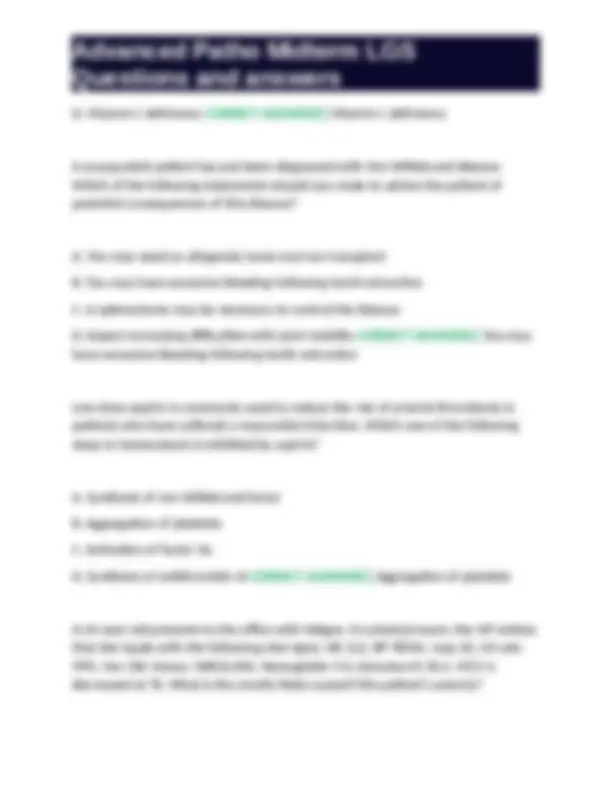
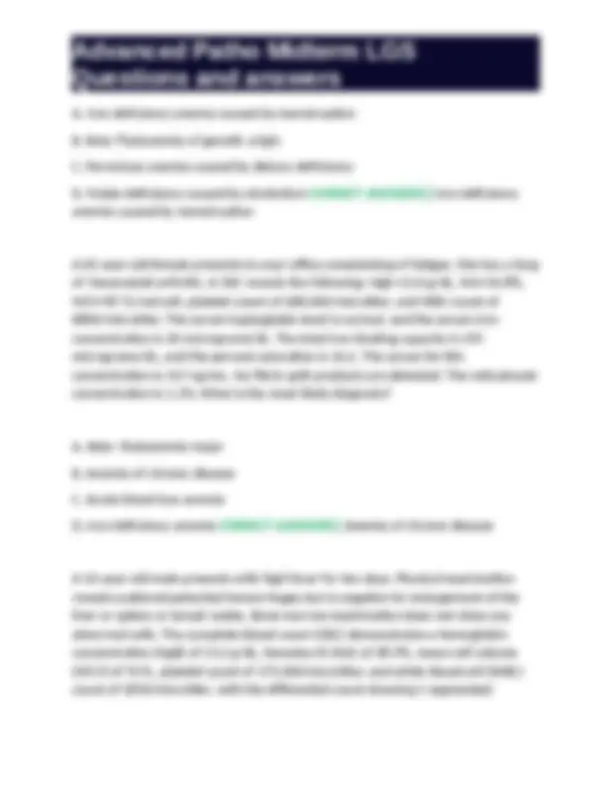
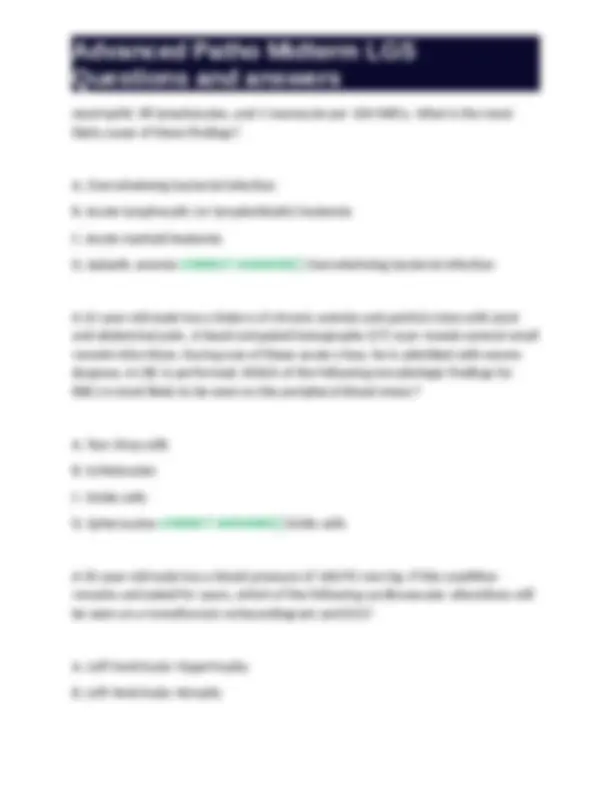
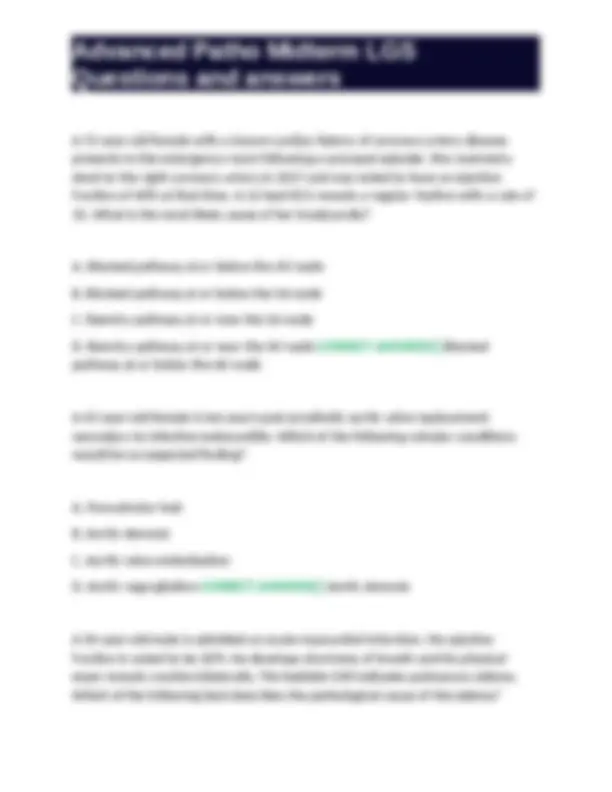
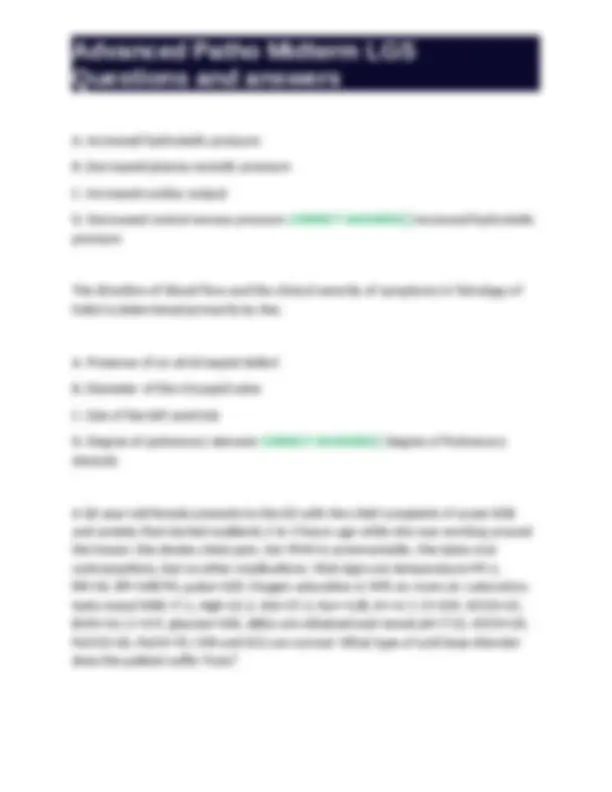
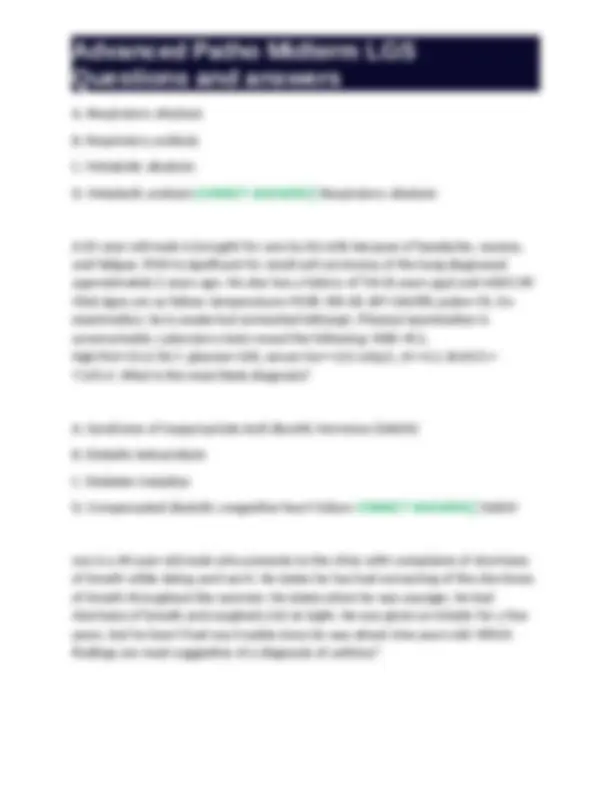
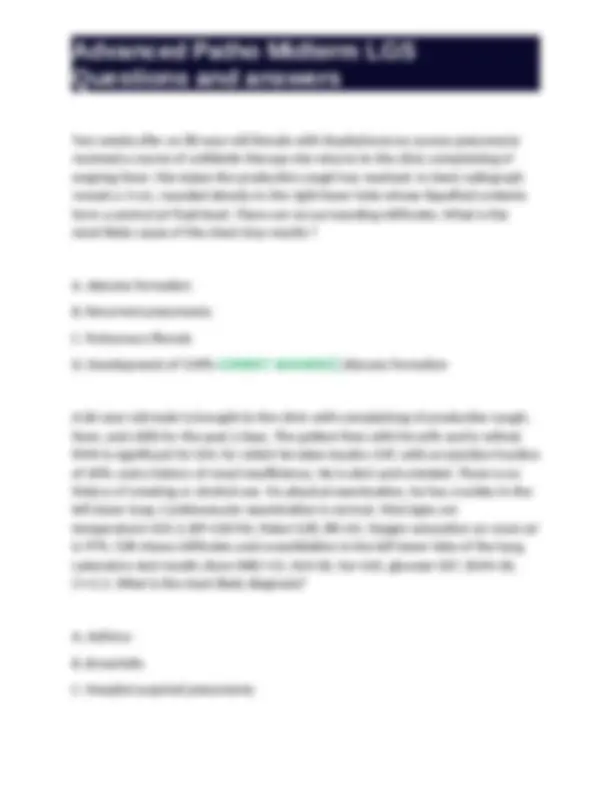
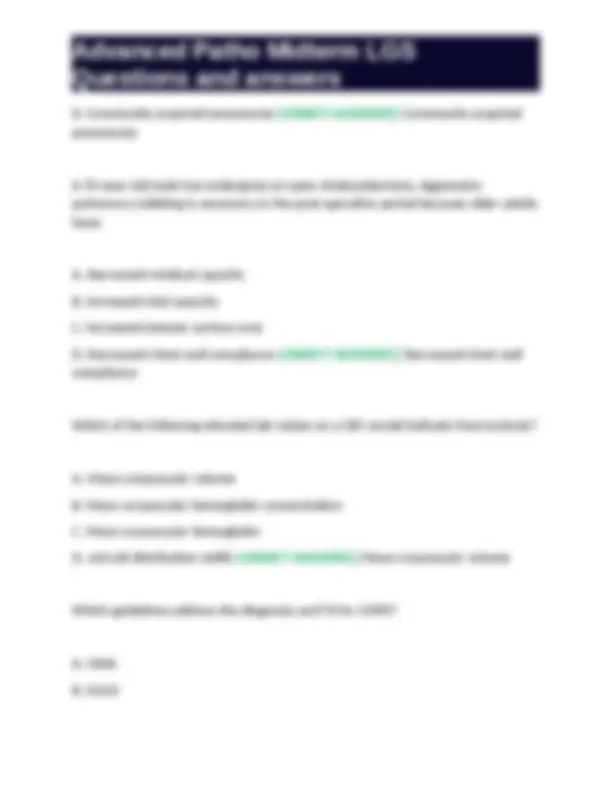
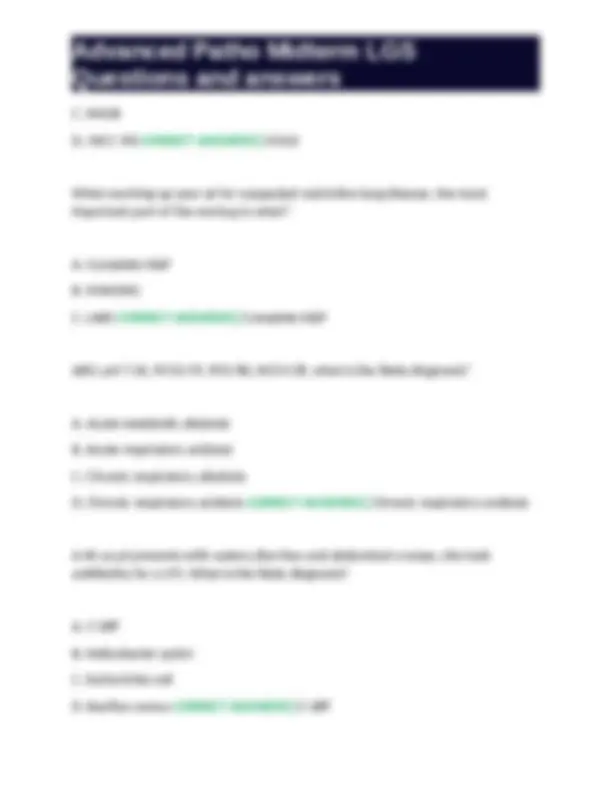
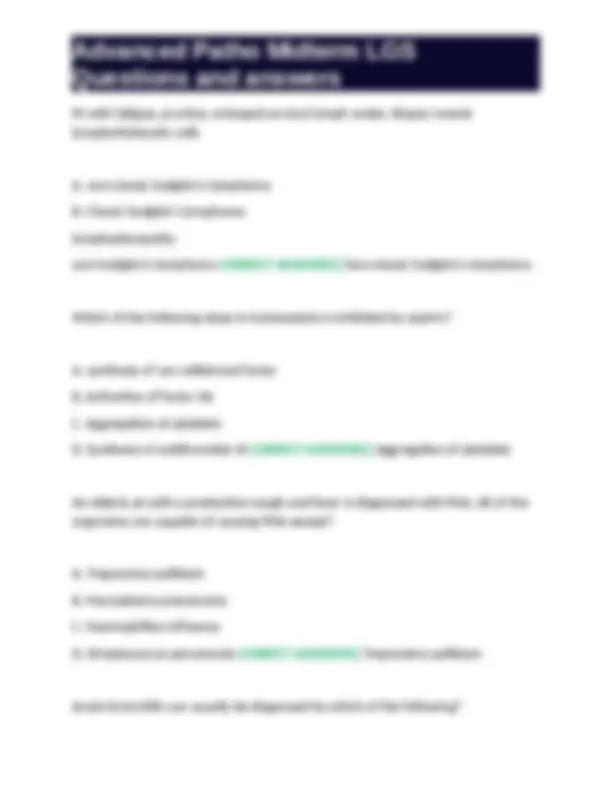
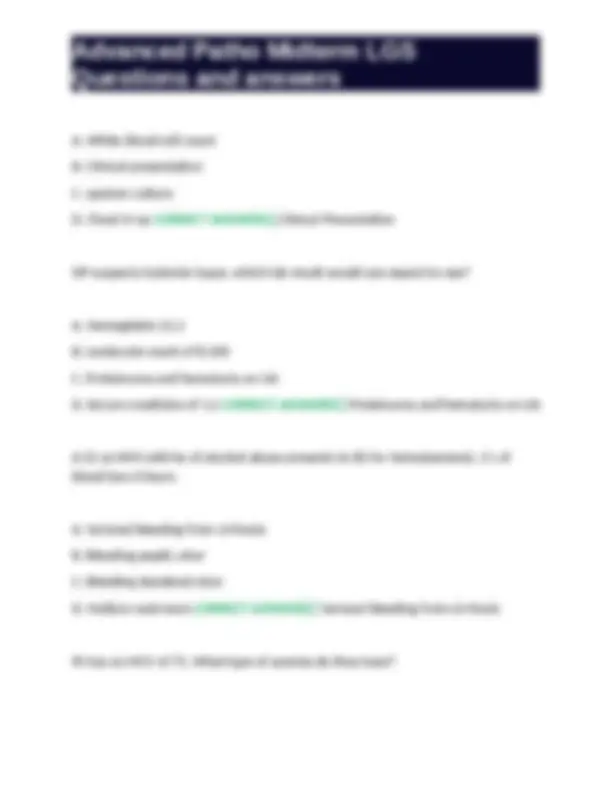
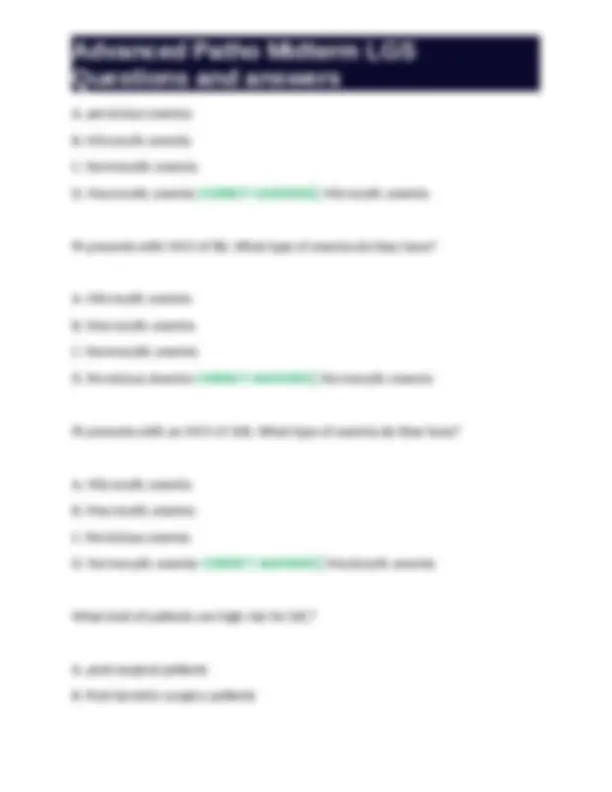
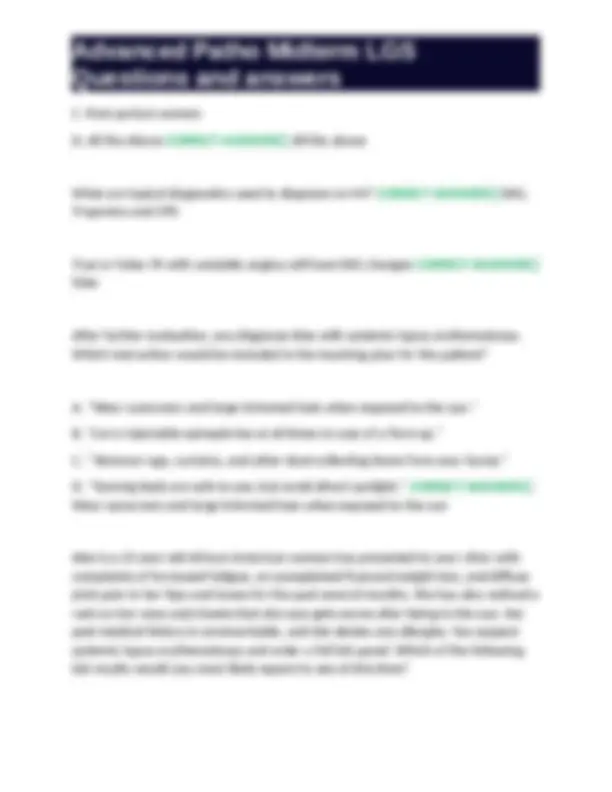
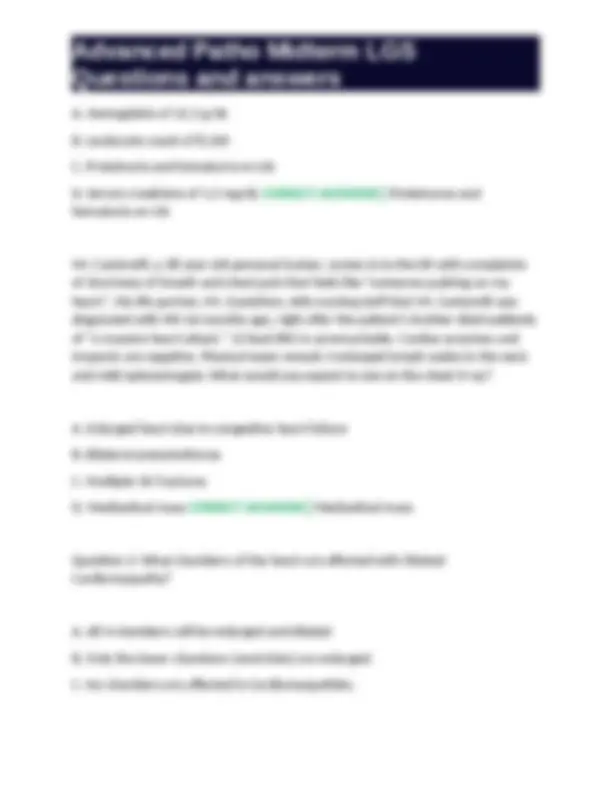
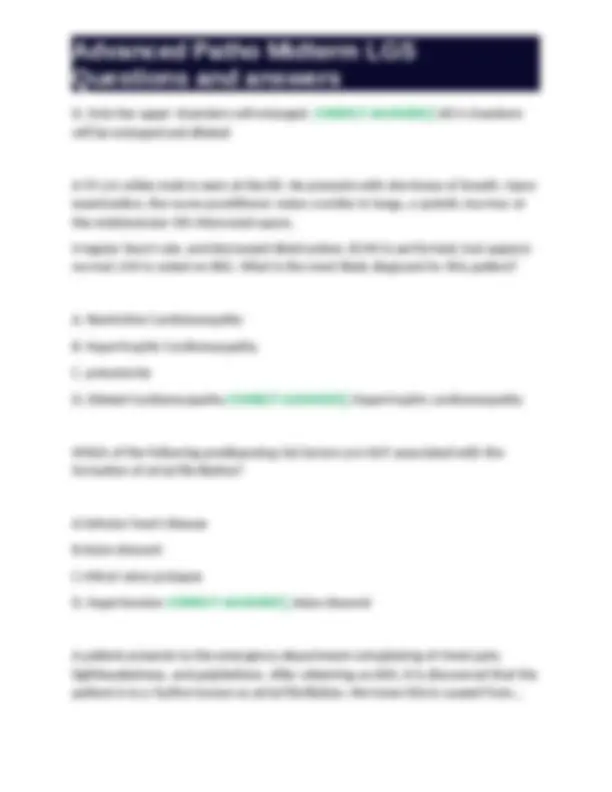
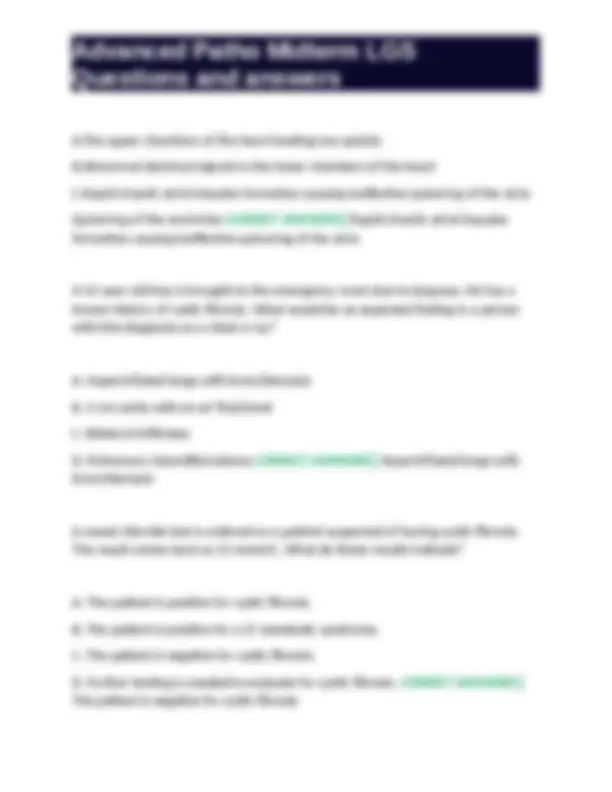
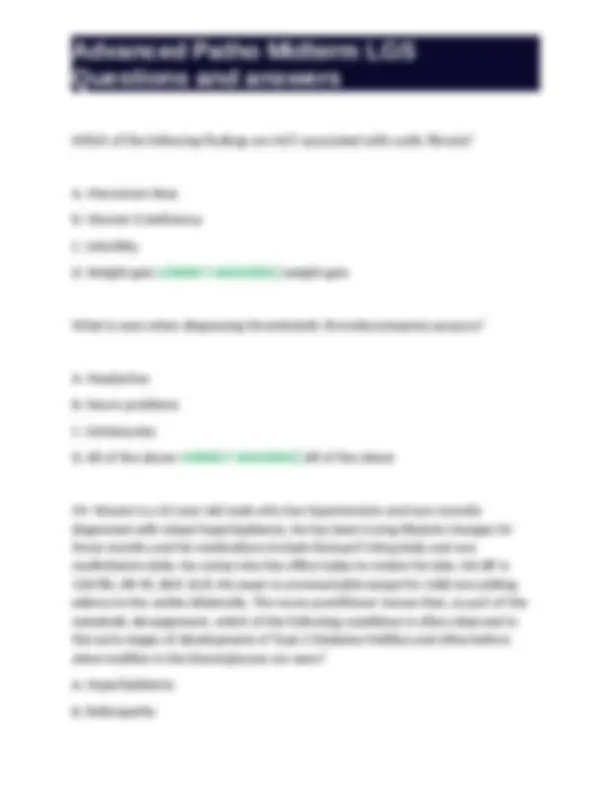
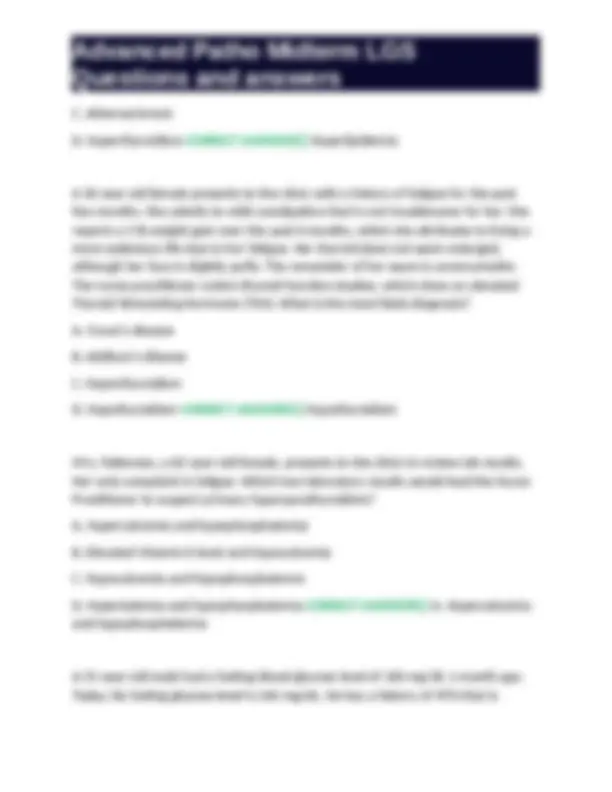
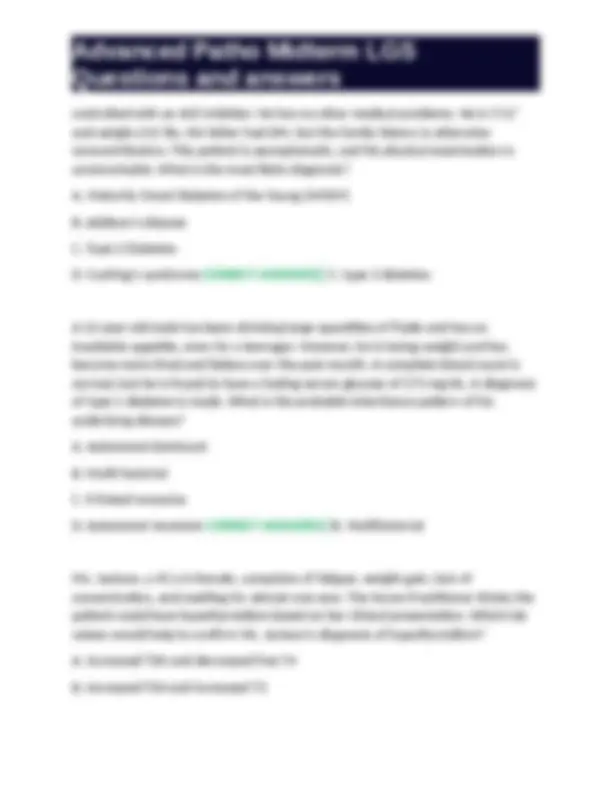
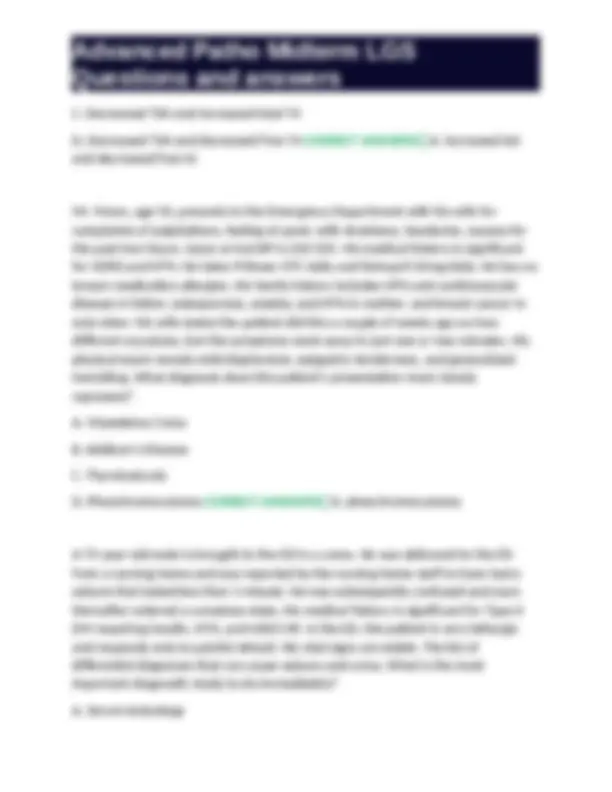
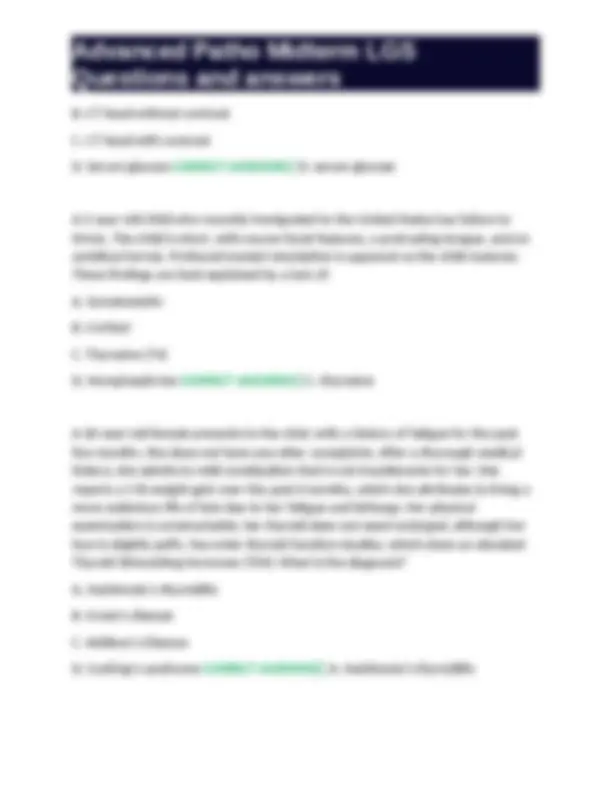
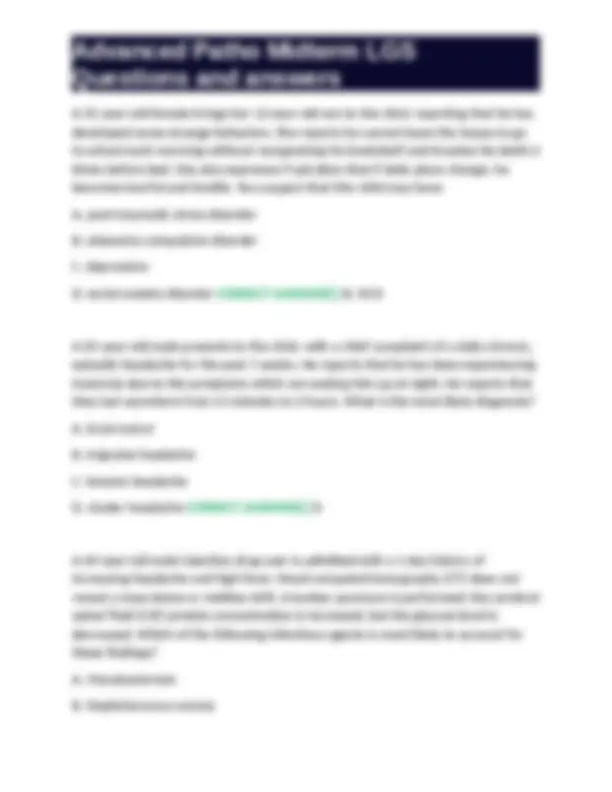
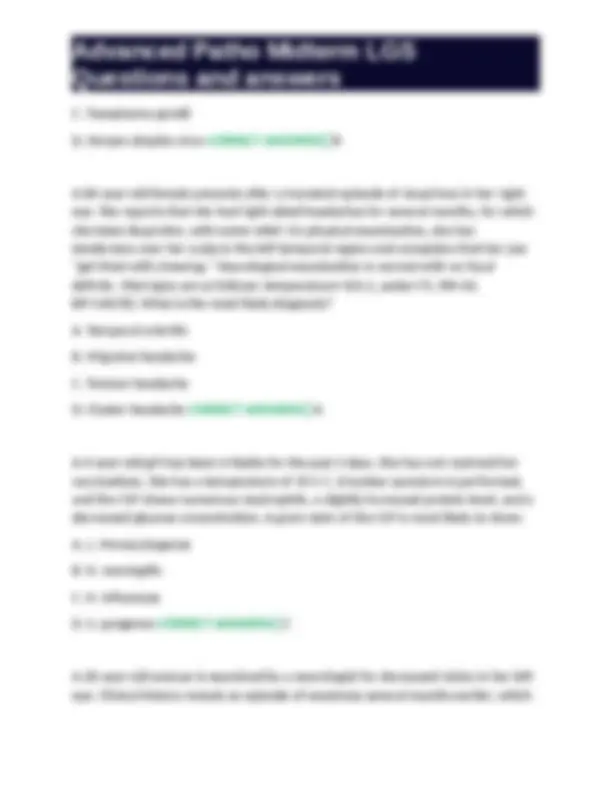
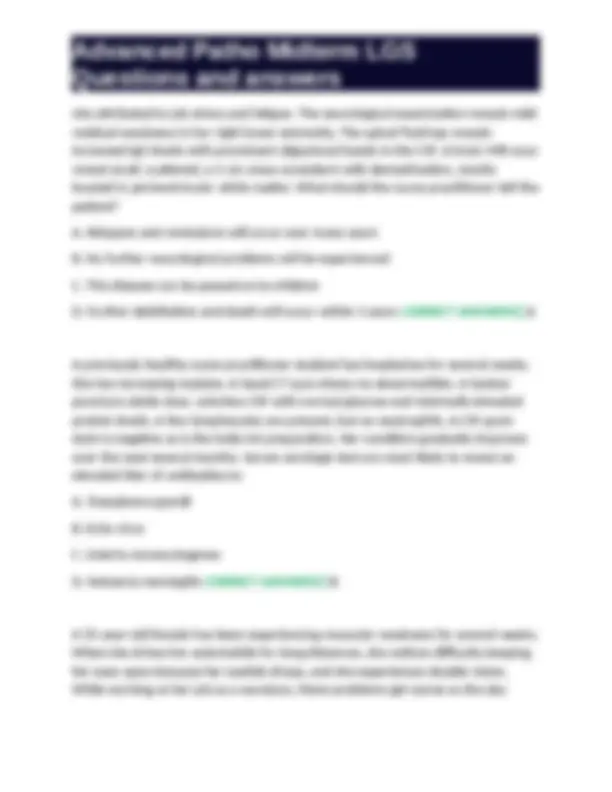
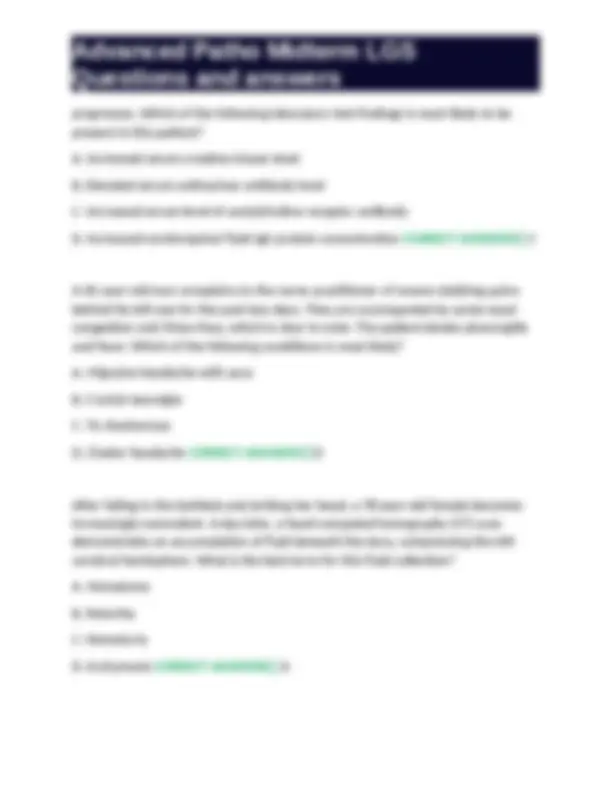
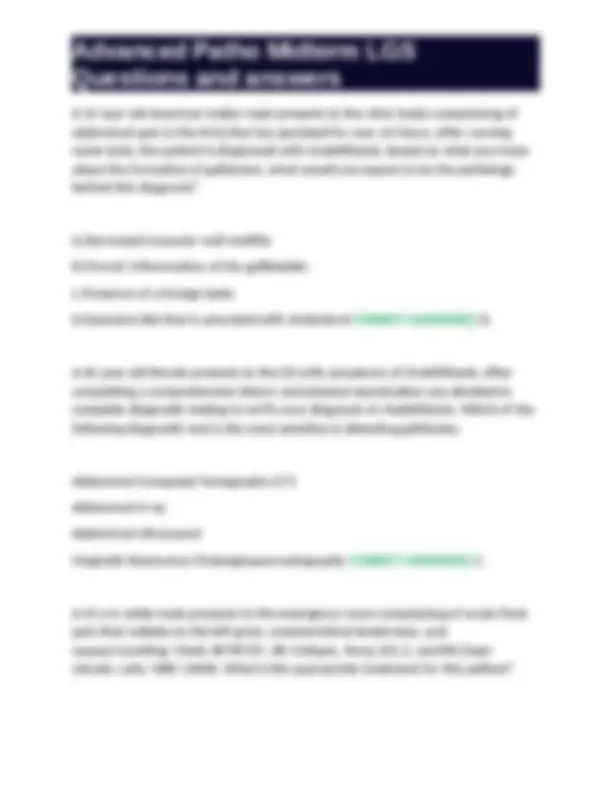
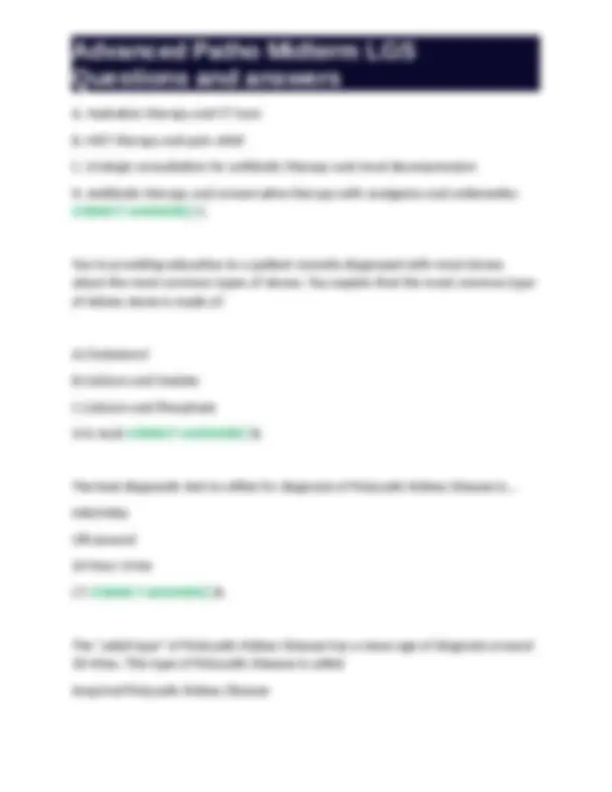
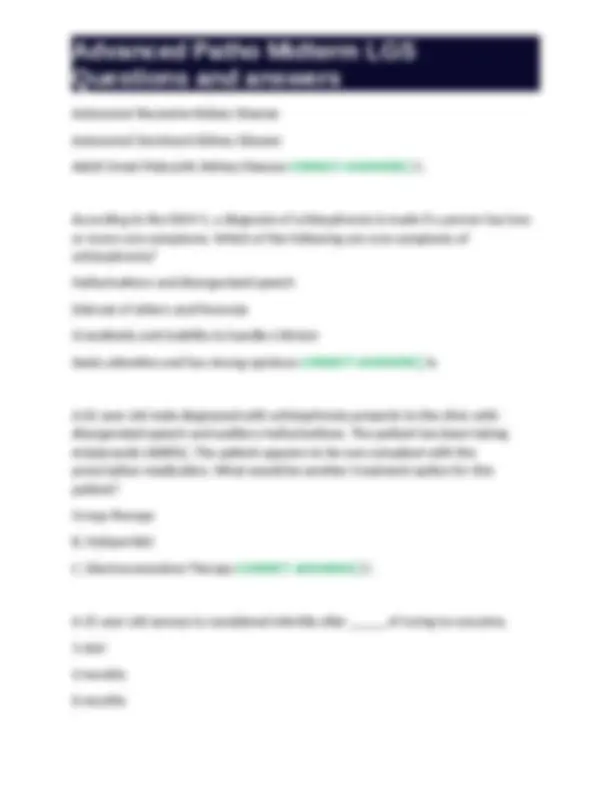
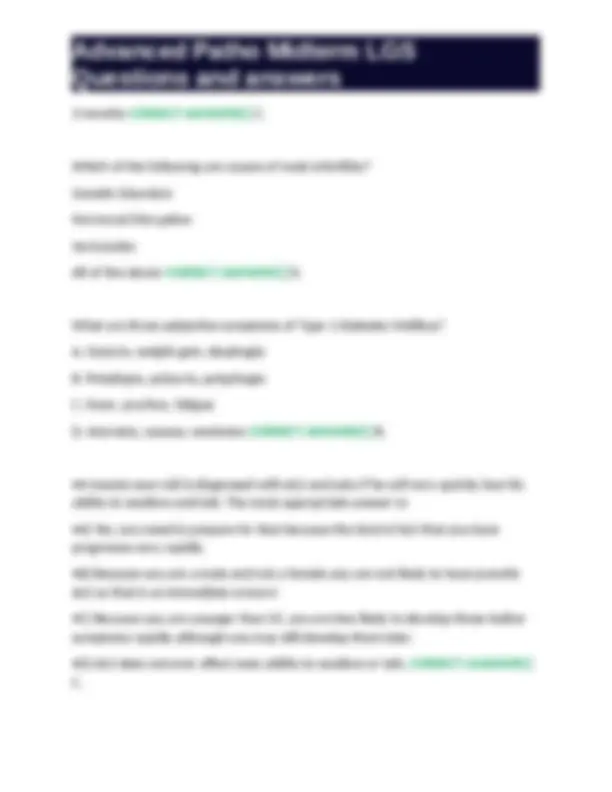
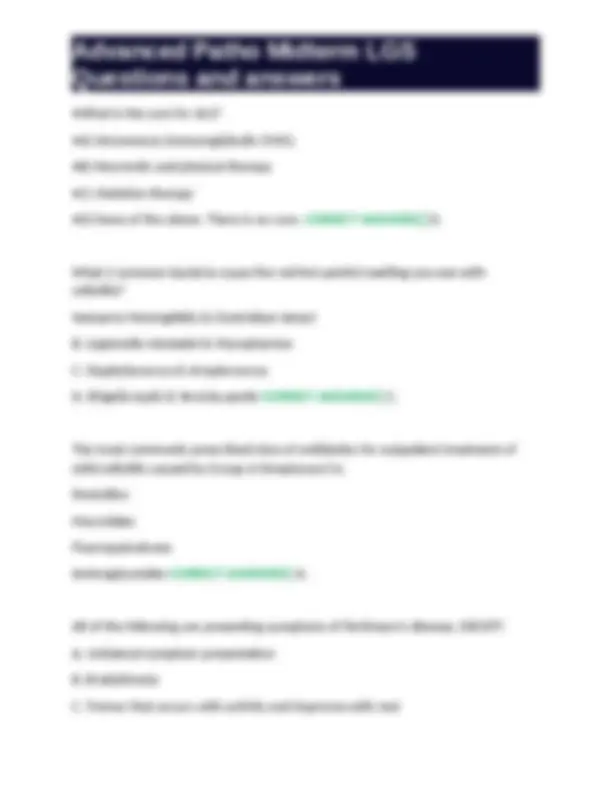
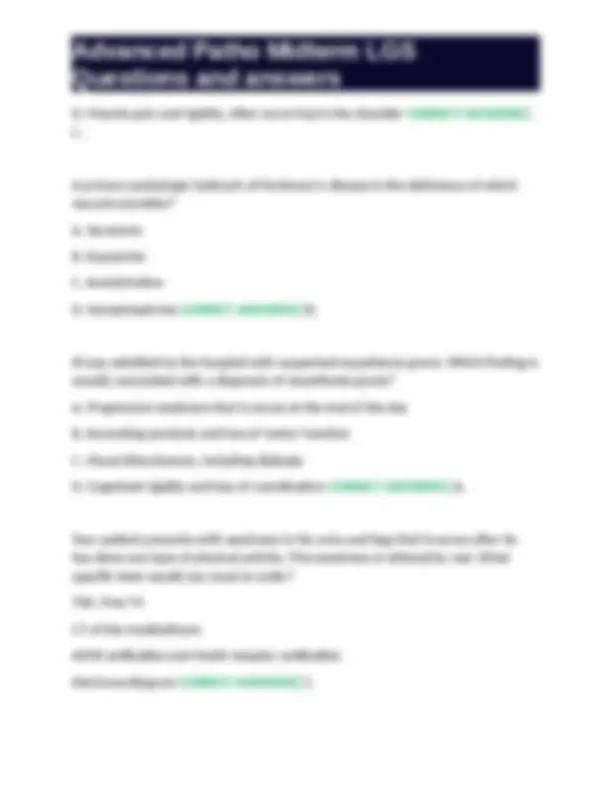
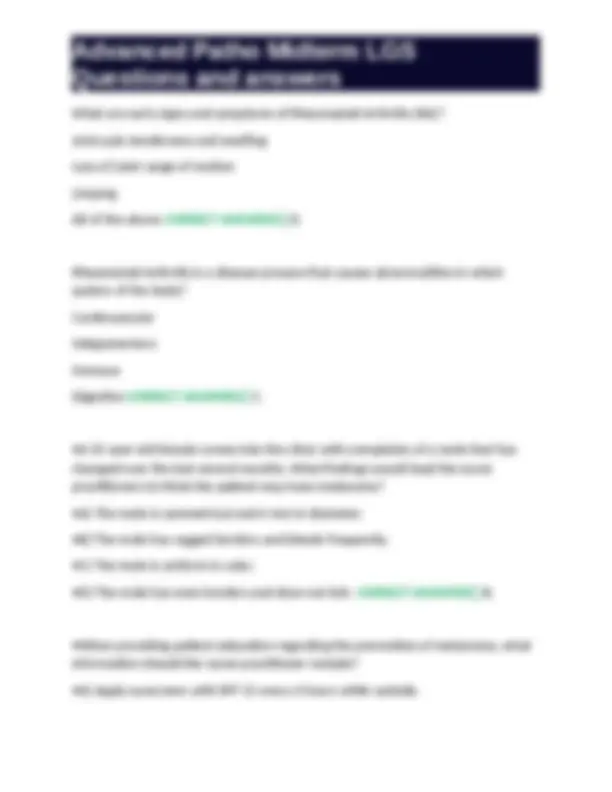
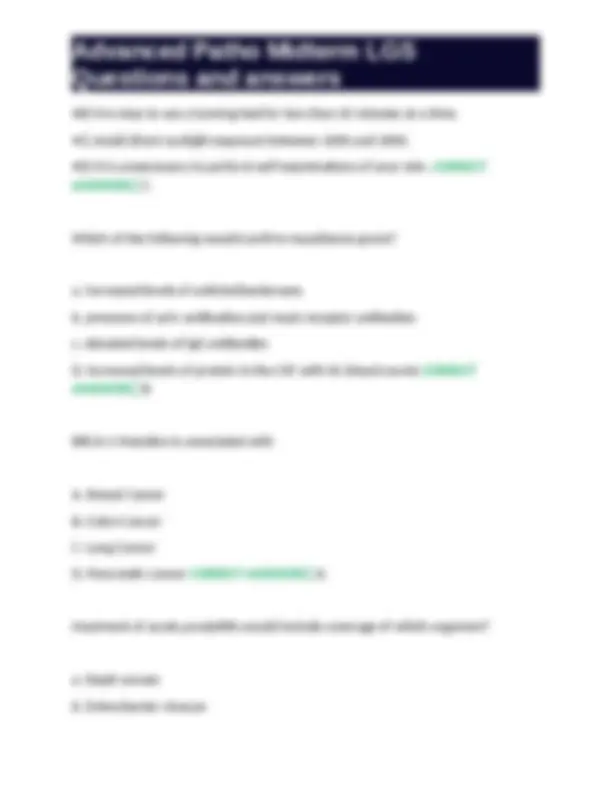
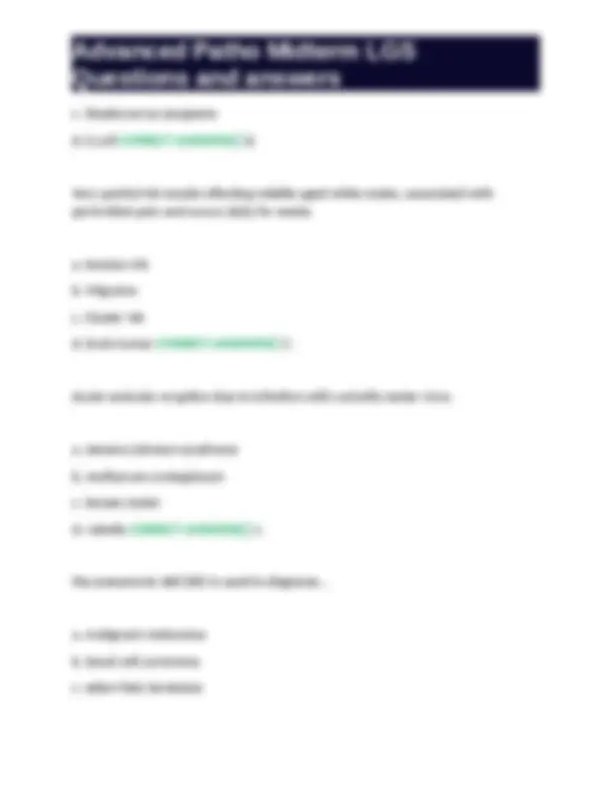
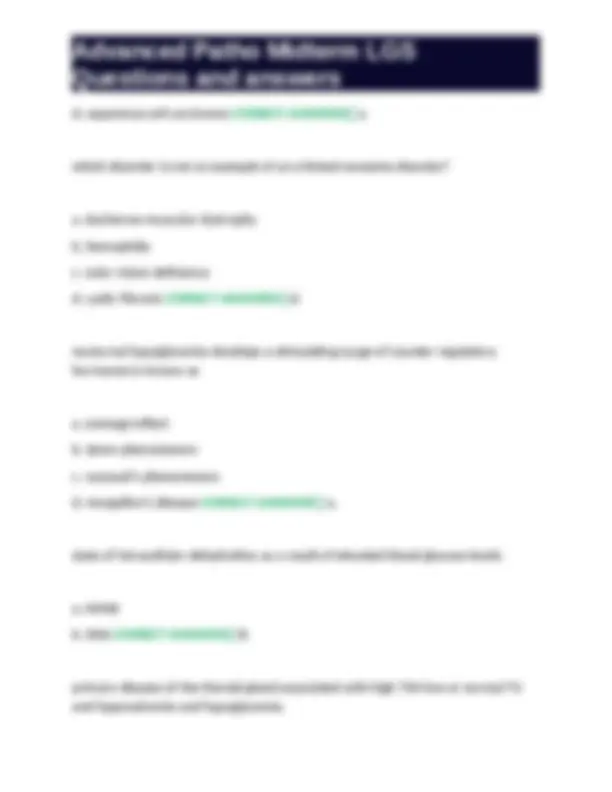
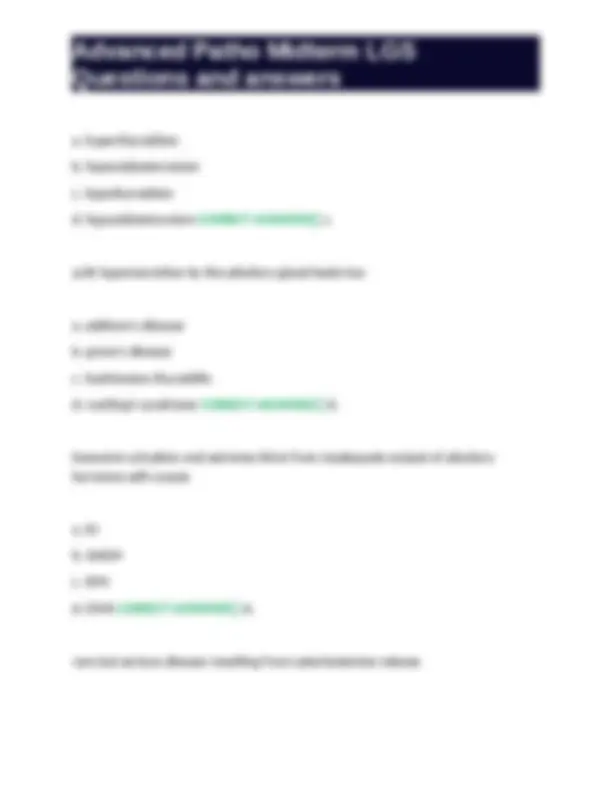
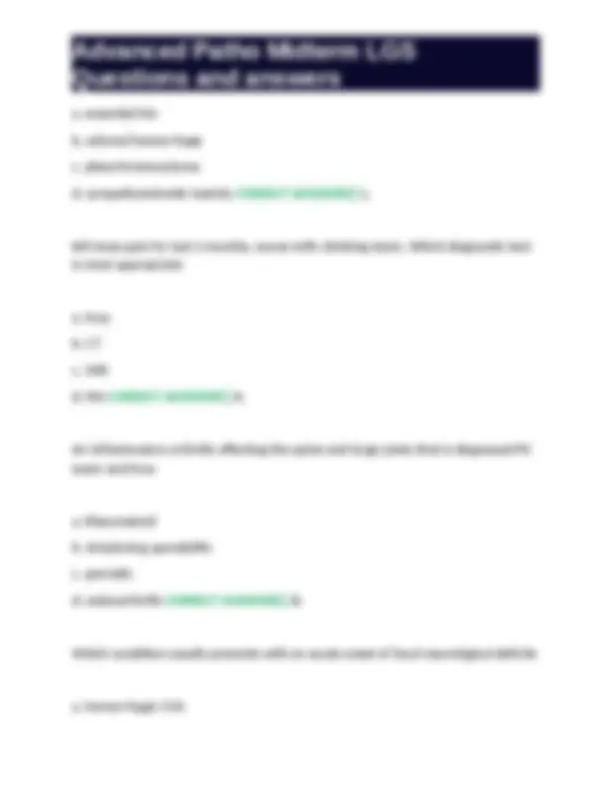
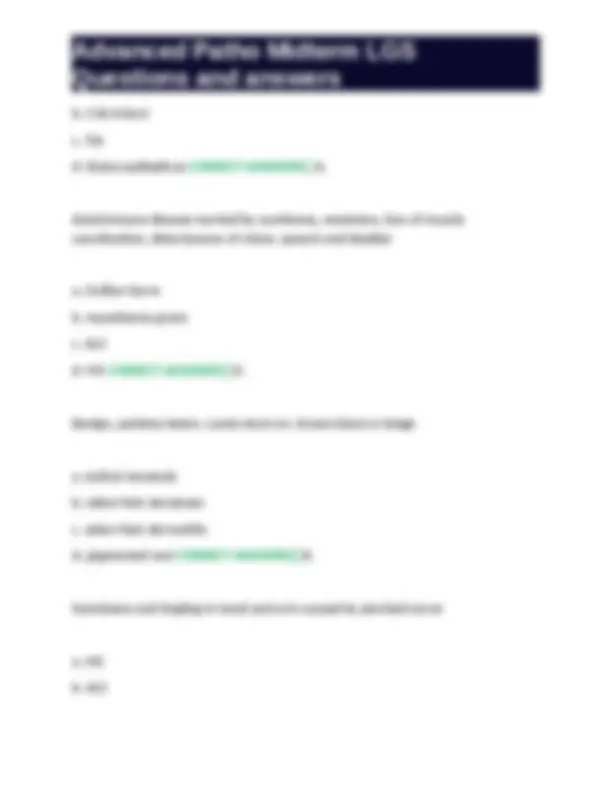



Study with the several resources on Docsity

Earn points by helping other students or get them with a premium plan


Prepare for your exams
Study with the several resources on Docsity

Earn points to download
Earn points by helping other students or get them with a premium plan
Community
Ask the community for help and clear up your study doubts
Discover the best universities in your country according to Docsity users
Free resources
Download our free guides on studying techniques, anxiety management strategies, and thesis advice from Docsity tutors
Advanced Patho Midterm LGS Questions and answers
Typology: Exams
1 / 47

This page cannot be seen from the preview
Don't miss anything!








































A 4-year-old child appears listless for the last week. He complains of pain when he is picked up by his mother, and he is irritable when touching his arms or legs. Several large ecchymotic lesions have appeared on his right thigh and left shoulder. A complete blood count reveals a HgB=10.2, Hct=30.5%, MCV=96fL, platelet count of 45,000/ML, and WBC count of 13,990/ML. Examination of the peripheral blood smear reveals numerous blasts. The blasts lack peroxidase- positive granules but do contain periodic acid-Schiff (PAS)-positive aggregates and stain positively for TdT. Flow cytometry shows the phenotype of blasts to be CD19+, CD3-, and sIg-. What is the most likely diagnosis? A. Acute lymphoblastic leukemia (ALL) B. Chronic lymphocytic leukemia (CLL) C. Acute myelogenous leukemia (AML) D. Chronic myelogenous leukemia (CML) CORRECT ANSWERS✅ Acute lymphblastic leukemia A 3-year-old child of Italian ancestry presents with failure to thrive. Physical examination indicates hepatosplenomegaly. His hemoglobin concentration is 6 g/dL, and the peripheral blood smear reveals severely hypochromic microcytic red cells. Total serum iron level is normal. The reticulocyte count is 10%. Hemoglobin electrophoresis shows very little hemoglobin A. A radiograph of the skull shows maxillofacial deformities. What is the principle cause of anemia and other abnormalities in this patient? A. Reduced synthesis of hemoglobin F B. Reduced red blood cell survival from imbalance in the production of alpha and beta globin chains C. Relative deficiency of vitamin B
D. Increased fragility of the erythrocyte membrane CORRECT ANSWERS✅ Reduced synthesis of hemoglobin F A 68-year-old previously healthy female has been feeling increasingly tired and weak for several months. She states that she has had black, tarry stools for several weeks. She is found to be anemic with a hemoglobin concentration of 9.3g/dL. The peripheral blood smear reveals microcytic and hypochromic blood cells. Which of the following conditions should be suspected as the most likely of her condition as indicated by the peripheral blood smear? A. Aplastic anemia B. Beta thalassemia C. Gastrointestinal blood loss D. Pernicious anemia CORRECT ANSWERS✅ Gastrointestinal blood loss A 76-year-old female notices that small, pinpoint to blotchy areas of superficial hemorrhage have appeared on her gums and on the skin of her arms and legs over several weeks. She is found to have a normal prothrombin time(PT) and partial thromboplastin time (PTT). Her CBC shows hemoglobin concentration of 12.7 g/dL, hematocrit of 37.2%. MCV of 80 fL/red cell, platelet count of 276,000/microliter, and WBC of 5600/microliter. Her template bleeding time is 3 minutes. Her fibrinogen level is normal, and there are no fibrin split products detectable. Which of the following conditions best explain these findings? A. Chronic renal failure B. Macronodular cirrhosis C. Vitamin B12 deficiency
A. Iron deficiency anemia caused by menstruation B. Beta Thalassemia of genetic origin C. Pernicious anemia caused by dietary deficiency D. Folate deficiency caused by alcoholism CORRECT ANSWERS✅ Iron deficiency anemia caused by menstruation A 65-year-old female presents to your office complaining of fatigue. She has a long of rheumatoid arthritis. A CBC reveals the following: Hgb=11.6 g/dL, Hct=34.8%, MCV=87 fL/red cell, platelet count of 268,000/microliter, and WBC count of 6800/microliter. The serum haptoglobin level is normal, and the serum iron concentration is 20 micrograms/dL. The total iron binding capacity is 195 micrograms/dL, and the percent saturation is 10.2. The serum ferritin concentration is 317 ng/mL. No fibrin split products are detected. The reticulocyte concentration is 1.1%. What is the most likely diagnosis? A. Beta- thalassemia major B. Anemia of chronic disease C. Acute blood loss anemia D. Iron deficiency anemia CORRECT ANSWERS✅ Anemia of chronic disease A 14-year-old male presents with high fever for ten days. Physical examination reveals scattered petechial hemorrhages but is negative for enlargement of the liver or spleen or lymph nodes. Bone marrow examination does not show any abnormal cells. The complete blood count (CBC) demonstrates a hemoglobin concentration (HgB) of 13.2 g/dL, hematocrit (Hct) of 38.9%, mean cell volume (MCV) of 93 fL, platelet count of 175,000/microliter, and white blood cell (WBC) count of 1850/microliter, with the differential count showing 1 segmented
neutrophil, 98 lymphocytes, and 1 monocyte per 100 WBCs. What is the most likely cause of these findings? A. Overwhelming bacterial infection B. Acute lymphocytic (or lymphoblastic) leukemia C. Acute myeloid leukemia D. Aplastic anemia CORRECT ANSWERS✅ Overwhelming bacterial infection A 31-year-old male has a history of chronic anemia and painful crises with joint and abdominal pain. A head computed tomography (CT) scan reveals several small remote infarctions. During one of these acute crises, he is admitted with severe dyspnea. A CBC is performed. Which of the following morphologic findings for RBCs is most likely to be seen on the peripheral blood smear? A. Tear drop cells B. Schistocytes C. Sickle cells D. Spherocytes CORRECT ANSWERS✅ Sickle cells A 50-year-old male has a blood pressure of 160/95 mm Hg. If this condition remains untreated for years, which of the following cardiovascular alterations will be seen on a transthoracic echocardiogram and ECG? A. Left Ventricular Hypertrophy B. Left Ventricular Atrophy
D. Acute myocardial infarction CORRECT ANSWERS✅ Aortic dissection A 45-year-old male collapsed suddenly while playing basketball. Bystander CPR and defibrillation was performed using an automatic external defibrillator or AED. When EMS arrived, the gentleman was awake and alert. The recorded rhythm strip on the AED shows tachycardia with AV dissociation (rate, approximately 220 bpm). Which arrhythmia induced his arrest? A. Nonsustained supraventricular tachycardia B. Sustained wide complex atrial tachycardia C. Wide complex ventricular tachycardia D. Narrow complex ventricular tachycardia CORRECT ANSWERS✅ Wide complex tachycardia A 44-year-old previously healthy male presents to the office complaining of increasing dyspnea on exertion and exercise intolerance over the last six months. The NP order a chest XRAY and transthoracic echocardiogram. The chest XRAY shows an enlarged heart and mild pulmonary edema. The echocardiogram reveals four-chamber cardiac dilation with an ejection fraction of 30% and mitral and tricuspid valve regurgitation. The patient is referred to the cardiologist who orders a CAT scan of the coronary arteries which is negative for obstructive coronary artery disease. What is the most likely underlying cause of the dyspnea? A. Idiopathic dilated cardiomyopathy B. Rheumatic heart disease C. Hemochromatosis D. Chagas disease CORRECT ANSWERS✅ Idiopathic dilated cardiomyopathy
A 72-year-old female with a known cardiac history of coronary artery disease presents to the emergency room following a syncopal episode. She received a stent to the right coronary artery in 2017 and was noted to have an ejection fraction of 40% at that time. A 12 lead ECG reveals a regular rhythm with a rate of
A. Respiratory alkalosis B. Respiratory acidosis C. Metabolic alkalosis D. Metabolic acidosis CORRECT ANSWERS✅ Respiratory alkalosis A 65-year-old male is brought for care by his wife because of headache, nausea, and fatigue. PMH is significant for small cell carcinoma of the lung diagnosed approximately 2 years ago. He also has a history of TIA (6 years ago) and mild CHF. Vital signs are as follow: temperature=99.8F, RR=18, BP=140/88, pulse=76. On examination, he is awake but somewhat lethargic. Physical examination is unremarkable. Laboratory tests reveal the following: WBC=8.3, Hgb/Hct=10.2/30.7, glucose=106, serum Na+=121 mEq/L, K+=4.3, BUN/Cr= 7.0/0.4. What is the most likely diagnosis? A. Syndrome of Inappropriate Anti-diuretic Hormone (SIADH) B. Diabetic ketoacidosis C. Diabetes Insipidus D. Compensated diastolic congestive heart failure CORRECT ANSWERS✅ SIADH Leo is a 40-year-old male who presents to the clinic with complaints of shortness of breath while doing yard work. He states he has had worsening of the shortness of breath throughout the summer. He states when he was younger, he had shortness of breath and coughed a lot at night. He was given an inhaler for a few years, but he hasn't had any trouble since he was about nine years old. Which findings are most suggestive of a diagnosis of asthma?
A. Dry cough during exam, respiratory rate of 20 breaths/minute, and wheezing upon auscultation of posterior lower lung lobes. B. Dry cough noted during the exam, Sp02=96%, FEV1 <80% predicted, and FEV increased 15% after administration of a short-acting bronchodilator. C. Bilateral wheezing noted on auscultation, Sp02=95%, and heart rate of 86 D. Pale, boggy nasal turbinates, dry cough, FEV1 <80% predicted and FEV increased 5% after administration of a short-acting broncho CORRECT ANSWERS✅ Dry cough noted during exam, Sp02=96%, FEV1 <80% predicted, and FEV increased 15% after administration of short acting bronchodilator. Which of the following symptoms is generally NOT considered a typical finding in someone with active tuberculosis infection? A. Weight loss B. Fever in the morning C. Night sweats D. Hemoptysis CORRECT ANSWERS✅ Fever in the morning A 43-year-old female presents to the clinic with a 2-day history of cough and fever. She states that she has felt tired for the past couple of weeks. Past medical history is unremarkable. On physical examination, she appears ill and has a persistent cough, productive of purulent sputum. She has crackles in her right posterior chest. BP=126/74, pulse=80, RR=24, temperature 102.2. WBC count is 14,000/mm3. What diagnostic test should be done first? A. Sputum culture
Two weeks after an 80-year-old female with Staphylococcus aureus pneumonia received a course of antibiotic therapy she returns to the clinic complaining of ongoing fever. She states the productive cough has resolved. A chest radiograph reveals a 3 cm, rounded density in the right lower lobe whose liquefied contents form a central air-fluid level. There are no surrounding infiltrates. What is the most likely cause of the chest Xray results? A. Abscess formation B. Recurrent pneumonia C. Pulmonary fibrosis D. Development of COPD CORRECT ANSWERS✅ Abscess formation A 66-year-old male is brought to the clinic with complaining of productive cough, fever, and chills for the past 2 days. The patient lives with his wife and is retired. PMH is significant for DM, for which he takes insulin; CHF, with an ejection fraction of 40%; and a history of renal insufficiency. He is alert and oriented. There is no history of smoking or alcohol use. On physical examination, he has crackles in the left lower lung. Cardiovascular examination is normal. Vital signs are temperature=103.3, BP=130/64, Pulse=128, RR=24. Oxygen saturation on room air is 97%. CXR shows infiltrates and consolidation in the left lower lobe of the lung. Laboratory test results show WBC=15, Hct=36, Na=142, glucose=167, BUN=36, Cr=1.5. What is the most likely diagnosis? A. Asthma B. Bronchitis C. Hospital acquired pneumonia
D. Community acquired pneumonia CORRECT ANSWERS✅ Community acquired pneumonia A 70-year-old male has undergone an open cholecystectomy. Aggressive pulmonary toileting is necessary in the post-operative period because older adults have: A. Decreased residual capacity B. Increased vital capacity C. Increased alveolar surface area D. Decreased chest wall compliance CORRECT ANSWERS✅ Decreased chest wall compliance Which of the following elevated lab values on a CBC would indicate Macrocytosis? A. Mean corpuscular volume B. Mean corpuscular hemoglobin concentration C. Mean corpuscular hemoglobin D. red cell distribution width CORRECT ANSWERS✅ Mean corpuscular volume Which guidelines address the diagnosis and TX for COPD? A. GINA B. GOLD
Pulmonary fibrosis, aspiration, and bronchiostasis are examples of restrictive lung disease, which statement is true? A. prohibits air from flowing out of alveoli, trapping air in the lungs B. Prohibits air from flowing into the alveoli by not allowing chest expansion C. There is an increase in the compliance of lung tissue D. Lung volumes are increased CORRECT ANSWERS✅ Prohibits air from flowing into the alveoli by not allowing chest expansion Which of the following signs are associated with hypocalcemia? A. Obturator signs B. Chandelier sign C. Chvostek sign D. Homans sign CORRECT ANSWERS✅ Chvostek sign The most common infection in persons with AIDS? (80% Occurrence) A. pneumocystic pneumonia B. Mycobaterium tuberculosis C. Legionnaires D. Cytomegalovirus CORRECT ANSWERS✅ Pneumocystic pneumonia
How low must the CD4+ count be before a patient can be considered as having AIDS? A. < 20, B. < 200 C. < 2, D. <2,500 CORRECT ANSWERS✅ < 200 The NP has learned that her patient's tumor is benign, what characteristics will the benign tumor have? A. Well differentiated B. High mitotic index C. not encapsulated D. Grow rapidly CORRECT ANSWERS✅ Well differentiated An echo indicated greatly hypertrophied left ventricular wall, what is most likely the cause? A. Chronic alcoholism B. Emphysema C. Acute AMI D. Hypertension CORRECT ANSWERS✅ Hypertension
A. White blood cell count B. Clinical presentation C. sputum culture D. Chest X-ray CORRECT ANSWERS✅ Clinical Presentation NP suspects Systemic lupus, which lab result would you expect to see? A. Hemoglobin 12. B. Leukocyte count of 8, C. Proteinurea and hematuria on UA D. Serum creatinine of 1.2 CORRECT ANSWERS✅ Proteinurea and hematuria on UA A 52 yo WM with hx of alcohol abuse presents to ED for hemataemesis. 2 L of blood loss 6 hours. A. Variceal bleeding from cirrhosis B. Bleeding peptic ulcer C. Bleeding duodenal ulcer D. Mallory-weis tears CORRECT ANSWERS✅ Variceal bleeding from cirrhosis Pt has an MCV of 75. What type of anemia do they have?
A. pernicious anemia B. Microcytic anemia C. Normocytic anemia D. Macrocytic anemia CORRECT ANSWERS✅ Microcytic anemia Pt presents with MCV of 86. What type of anemia do they have? A. Microcytic anemia B. Macrocytic anemia C. Normocytic anemia D. Pernicious Anemia CORRECT ANSWERS✅ Normocytic anemia Pt presents with an MCV of 106. What type of anemia do they have? A. Microcytic anemia B. Macrocytic anemia C. Pernicious anemia D. Normocytic anemia CORRECT ANSWERS✅ Mactocytic anemia What kind of patients are high risk for DIC? A. post-surgical patients B. Post bariatric surgery patients